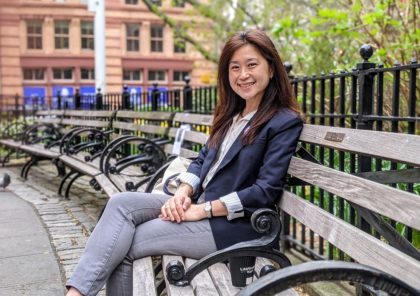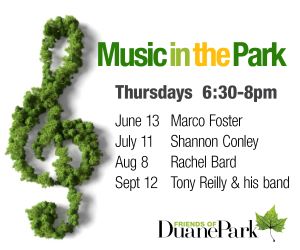City Council Primary 2023: Susan Lee
We will have a primary on June 27 for our City Council District 1 seat, currently occupied by Christopher Marte. And since there are a few hot issues right now, I sent the candidates (those who had contact info on their sites) a short list of questions gleaned from comments. I will run the responses in the order they are returned.
Sidewalk sheds surrounding buildings dealing with Local Law 11 as well as sheds that take over sidewalks have plagued this neighborhood for decades. (In fact some sheds have been up for decades!) Do you have any plans or solutions?
Sidewalk sheds/scaffoldings are unsightly; they are magnets for loiterers, public urination and rats. As a resident of Tribeca, I see this daily at the corner of Church and Chambers Streets. The average shed is up for 480 days, with approximately 240 lasting five years. The sheds also make businesses under them less inviting. Currently, sidewalk shed permits are valid for 12 months or when the insurance expires whichever is shorter. Violations for sheds up passed their permitted period can be as high as $8,000.
As I have proposed in 2021’s Tribeca Citizen candidate questionnaire, I strongly support shortening the permit period to six months. If work that is being done on the property takes longer than six months, property owners can apply for an extension for another 6 months. By breaking up the 12-month permit into two six-month permits, it will incentivize property owners to complete remediation work faster in order to avoid paying additional application and filing fees. Property owners’ compliance with these proposed recommendations would avoid having their requests for extension denied. If the sheds are up beyond their permitted time, a penalty fee will be issued.
Cars with fake parking placards clog our local streets every day, blocking commercial parking and creating problems not just for residents but for businesses trying to get deliveries. There are times when entire streets are blocked as a result. Do you have a solution for this?
Government workers are not the only ones who commit placard abuse. There are fake handicap placards and MTA yellow vests readily available for sale on the internet. Our district is riddled with placard abuse, especially the area south of Canal Street. Placard abuse increases congestion and poses a public safety risk. Oftentimes, those with placards get away with illegal and unsafe parking in front of fire hydrants, crosswalks, in bike lanes and sidewalks. Cyclists have to ride into traffic when a car is illegally parked in the bike lane. Residents with mobility issues cannot safely navigate sidewalks and crosswalks when cars are parked there.
To combat placard abuse, I support reduction of placards issued to municipal workers. I propose the use of a digital sticker so ticket agents can scan a bar code and verify if the placard is legally issued. Currently, the Department of Transportation has the ability to scan a vehicle’s registration barcode and issue tickets to any vehicle that is illegal parked, we can certainly apply this method to verify if the placard is legitimate.
Another point I want to emphasize is that placard abuse boils down to lack of enforcement. We need to protect ticketing agents from retaliatory action by placard abusers. Placard parking is prohibited in “no standing’ and “no stopping” zones, fire hydrants, bus stops, travel lanes, driveways and “area where a traffic hazard would be created”. That’s the law and everyone should follow it.
Congestion pricing is coming to the neighborhood soon. What is your take on how it should roll out?
When I ran in 2021, I supported congestion pricing but after listening to local business owners and residents, I have since changed my position and am against congestion pricing.
The cost will fall most heavily on those least able to pay, whether they live outside the zone and drive in for medical appointments, or are low-income residents within the zone, including senior citizens who have aged in place-whose children have moved to other boroughs and beyond and would be dissuaded from visiting.
Many senior citizens in neighborhoods designated as NORCs (Naturally Occurring Retirement Communities) along the Grand Street and elsewhere has limited access to subways. Neighborhoods like Battery Park City also have limited access to subways, they too, are strongly against congestion pricing.
With the possible exception of Times Square, our district is the most tourist-dependent neighborhood in the city. Chinatown has predominately low-wage employees-whether essential workers in healthcare, or restaurant workers- do not work nine-to-five shifts when mass transit is more convenient. Those workers, many pushed by skyrocketing rents to seek housing in other boroughs, do not have the flexibility for remote or hybrid schedules.
Even a lower off-peak congestion fee, projected between $7-$17 again depending on exemptions, is a serious burden. While, I deeply respect the motivations of supporters of congestion pricing, who have fought so hard to ameliorate automobile pollution, though neighborhoods outside the Central Business District north of 61st Street would likely see increased pollution from traffic looking to avoid the fee. Those objections are echoed today in opposition to congestion pricing from elected officials in Staten Island and the Bronx in particular, who argue the plan would simply shift the impacts of auto-generated pollution to those boroughs.
My primary concern, of course, is lower Manhattan, where I hope to become the next city councilmember. Congestion pricing will put an unnecessary burden on residents in the district who made downtown their home before it was even a thought in many legislators’ mind. Limiting the number of visitors through a costly pricing mechanism will also damage small and mid-size businesses that anchor the neighborhood and employ thousands of workers.
The Chinatown jail is paused temporarily but is on a schedule for demolition nonetheless. What is your hope for this site? How should the city proceed?
As this publication has documented, I was the first protestor arrested after sitting down on Baxter Street in our efforts to stop the demolition of the Chinatown jail on April 13, 2022. Since that time, I have worked with members of the community, through NUBC, on the adaptive reuse. However, about two weeks ago, the Adams Administration informed the community that adaptive reuse is not feasible, “our team of experts and engineers determined that attempting to create this jail within the existing structure could put the building at risk of collapse and irresponsibility risk the safety of community members and workers in the building.” As of now, the demolition will continue and my priority is the health and safety of the community. We need to put monitors in place not just to measure pollution but to identify what kind of materials are in the air and if they are hazardous.
Commissioner Molina estimates that the population under Corrections will reach 7,000 by 2024; however, the Borough Based Jails will only hold 3,300 individuals. This begs the question of where will the overflow of detainees go? I support the rebuilding of Rikers Island with reform for Corrections Officers and renovation of the facilities to bring it up to current standards. I propose a mental health ward and a system where social services such as re-entry training, work force development, etc are provided for detainees.
Dining sheds are controversial as you know – neighbors want to support local business and like the lively streetscape, but also have issues with some structures, especially ones that have overstepped and take up more than their fair share of the sidewalk. What should the future of sidewalk seating look like?
Open Restaurants has thrown a life-line to many restaurants during the pandemic. However, that time has passed and we need to remove the dining sheds. I do not support the current Open Restaurants Initiative. These outdoor dining sheds have created public safety concerns. Some outdoor dining structure obstruct access for emergency vehicles, delaying response time. The sheds along with sidewalk dining have created overcrowding on sidewalks which pose hazard conditions for pedestrians, people with strollers, and those with limited mobility.
The sheds have also created a public health issue. They are breeding ground for rodents. The streets where these structures occupied have not been properly cleaned since the sheds were erected. I strongly support the seasonal sidewalk cafés that was in used prior to the pandemic which is administered by the Department of Consumer Affairs.

















This candidate is completely against congestion pricing and any version of an outdoor dining program? Sounds like a politician better suited to the suburbs, or the outer boroughs.
The obsession w incentivizing and subsidizing every aspect of auto-centric life, in the country’s most urban, walkable and transit-rich city, is just mind boggling.
You’ve lost our household’s vote; we actually show up to primary elections :).
For real. Absurdly out of touch. Outdoor dining is wildly popular. Returning to limited pre-covid sidewalk cafes would be a huge step backwards. Removable/seasonal in-street and sidewalk cafes with tables/chairs/umbrellas (no structures), as is being designed by DCP, strikes the proper balance between valid health/safety concerns and efficient use of public space. And congestion pricing is huge win for the city as a whole across various metrics—congestion, pollution, revenue generation, noise, public safety, etc.—even if a select few will be negatively impacted.
Yeah, agreed. Big nope from me. Plus trying to have it both ways by saying she was for it before she was against it. Nothing has changed about the program and its plans and benefits. Either she didn’t do her research before, or she’s changing her mind due to political considerations. Either way, that’s a bad look.
My god, people. Just be prepared to pay to drive in the most congested part of Manhattan; it’s for the greater good, or did we forget what that is? Or use transit, in a transit-rich neighborhood. She sounds like Phil Murphy.
“Neighborhoods like Battery Park City also have limited access to subways” hahahaha
“The cost will fall most heavily on those least able to pay, whether they live outside the zone and drive in for medical appointments, or are low-income residents within the zone, including senior citizens who have aged in place-whose children have moved to other boroughs and beyond and would be dissuaded from visiting.”
So tired of this disingenuous ‘equity’ canard. I live in a NORC; why should we subsidize relatives driving into the city from their rich suburbs in North Jersey, Westchester, and Long Island when they can just as easily visit their parents and grandparents who have aged in place by using public transit? The streets around my block are clogged with their luxury SUVs; this isn’t an equity issue at all. If anyone has the means to pay and should be otherwise disincentivized from clogging our streets and driving in circles to park, it’s these folks.
We have to find ways to reduce private vehicle traffic, for all the reasons we already know : safety, noise, congestion, pollution (and yes, even electric vehicles generate pollution unless the electricity comes from a green/clean source. So it’s either congestion pricing or come up with some better alternative. Status quo is not working. Time to adapt.
As for the sheds, I can see the point of getting rid of them, but retaining outdoor dining at the same time. As I’ve mentioned a couple times, my preferred solution: widen sidewalks, and put sidewalk seating right up against the restaurant or café. Allow canopies (perhaps retractable) to cover the seating. So basically European café style. Design so there is no reduction in sidewalk pedestrian space, by the appropriate sidewalk widening. Seating can be removable or not. If any permanent structure is involved, that should be part of the building, built to code, and aesthetically fitting the building.
This avoids covering roadways which may need repair and access. This avoids the problem of reducing pedestrian space. It avoids the problem of service crossing over pedestrian traffic. And no sheds required.
And as for areas with little subway access, the solution is to add better bus or streetcar access.
Those who stand to gain the most from congestion processing are the least wealthy. The current system of prioritizing cars disproportionately benefits car owners, who are on average better off.
Has this lady ever walked in this district? If her concern is congested sidewalks, residents’ health, and lack of transit (seriously? In District 1?) but she is against CP and dining sheds, I would assume she would propose completely closing off streets to vehicular traffic in favor of bus lanes and widened sidewalks. There shouldn’t be free parking anywhere in the district then. This neighborhood is so dense and packed with tourists and locals alike, that seeing huge amounts of space devoted to to like 10% of people who drive while everyone else has to scramble and fight for the remaining scraps of space is absolutely mind-blowing. She needs to fix this logical dissonance in her head before attempting to represent the neighborhood.
Susan Lee is the worst choice you could make for Tribeca and for the rest of District 1. She’s a Republican masquerading as a progressive Democrat and has repeatedly surrendered to and perpetuated the hysteria generated by conservative politicians and media around bail reform and crime. all because she’s effectively a single-issue candidate (hate crimes against Asian NYers).
bail reform has been a complete disaster, crimes not prosecuted, homeless roaming streets, subway violence (yes even in Tribeca) and the biggest issues discussed here are dining sheds and congestion tax. no wonder this once great city is circling the drain.
Out of touch. 1) BPC is not that far from the subway. All BPC residents are within a short walk of a few of 1,2,3,A,C,E,4,5,6,N,R,W, and PATH trains. 2) BPC residents welcome congestion pricing. With fewer private vehicles downtown bus service will be speedier and more reliable. Everyone that isn’t addicted to free on street parking loves year round outdoor dining.
well, i live here and i agree with her on all of the above issues.
we need to remove the dining sheds. they are unsafe and unhealthy. it was ok to help the restaurants survive the lockdowns but now we have moved on.
congestion pricing is a just another government boondoggle just ask anyone who lives in london where it has been around for years and has not reduced congestion one bit.
Everybody, including Marte, is in agreement that dining “sheds” need to go.
The question is whether street space should continue to be used for outdoor dining and, if so, under what regulations.
Lee believes that it should not be used at all for outdoor dining, which is how things were under pre-covid sidewalk cafe policies. Placing that position alongside her position on congestion pricing, she is basically just a pro-car and pro-parking candidate—totally backwards in a place like Lower Manhattan.
The program that DOT is working to implement will not allow sheds in the street. It will allow removable tables, chairs, and umbrellas during seasonal weather. See the link below. Given the popularity of outdoor dining (and issues posed by cars), this is the future a walkable, transit-dense neighborhood needs.
https://www.nyc.gov/html/dot/html/pedestrians/openrestaurants.shtml
Arrival into central London by private car dropped by 48% since congesting pricing was instituted.
Meanwhile, actual visitors to the area increased, not decreased, over the same time period.
Latest Data Show (Again!) That London’s Congestion Pricing is Working
https://nyc.streetsblog.org/2023/02/06/latest-data-shows-again-that-londons-congestion-pricing-is-working
I’m not voting for anyone against congestion pricing. Chinatown is choked with traffic and somehow she sees this as a good thing?
Agreed. Total red flag. I also won’t vote for anyone against congestion pricing, unless they can propose a better solution to the traffic, transit, noise and air pollution, and safety issues involved.
Anyone but Marte. He’s void of any knowledge of how affordable housing is fianced. Solely a campaigner.
The candidate choices are weak. If she’s against congestion pricing I’m against her. Probably too late anyway as it will pass regardless of her position. If I hadn’t spent 10 years in SF politics before moving back I’d be far more involved. Local politics is pak full. And the current choices prove it
I would like her take on the constant smoke shops popping up in the neighborhood, the mentally ill homeless roaming the neighborhood. I am all for the dining shed (covid is over and these business are just being greedy now). Say no to congestion pricing. It affects teachers and city employees who don’t live near this area. What they need to do is fine delivery trucks who cause most of the traffic nightmare. Trucks and cars who block bus stops too.
I also live in Tribeca like those here. I find her positions reasonable. Simply, i think things have gotten worse during C. Marte’s tenure. Her ideas addresss concerns shared by many including those to worried about e-backlash to post here.